MGMT 6056 Project Cost Management
VerifiedAdded on 2021/10/29
|21
|2302
|40
AI Summary
Contribute Materials
Your contribution can guide someone’s learning journey. Share your
documents today.

Running head: PROJECT MANAGEMENT
Human resource management system
Name of the Student
Name of the University
Author’s Note
Human resource management system
Name of the Student
Name of the University
Author’s Note
Secure Best Marks with AI Grader
Need help grading? Try our AI Grader for instant feedback on your assignments.
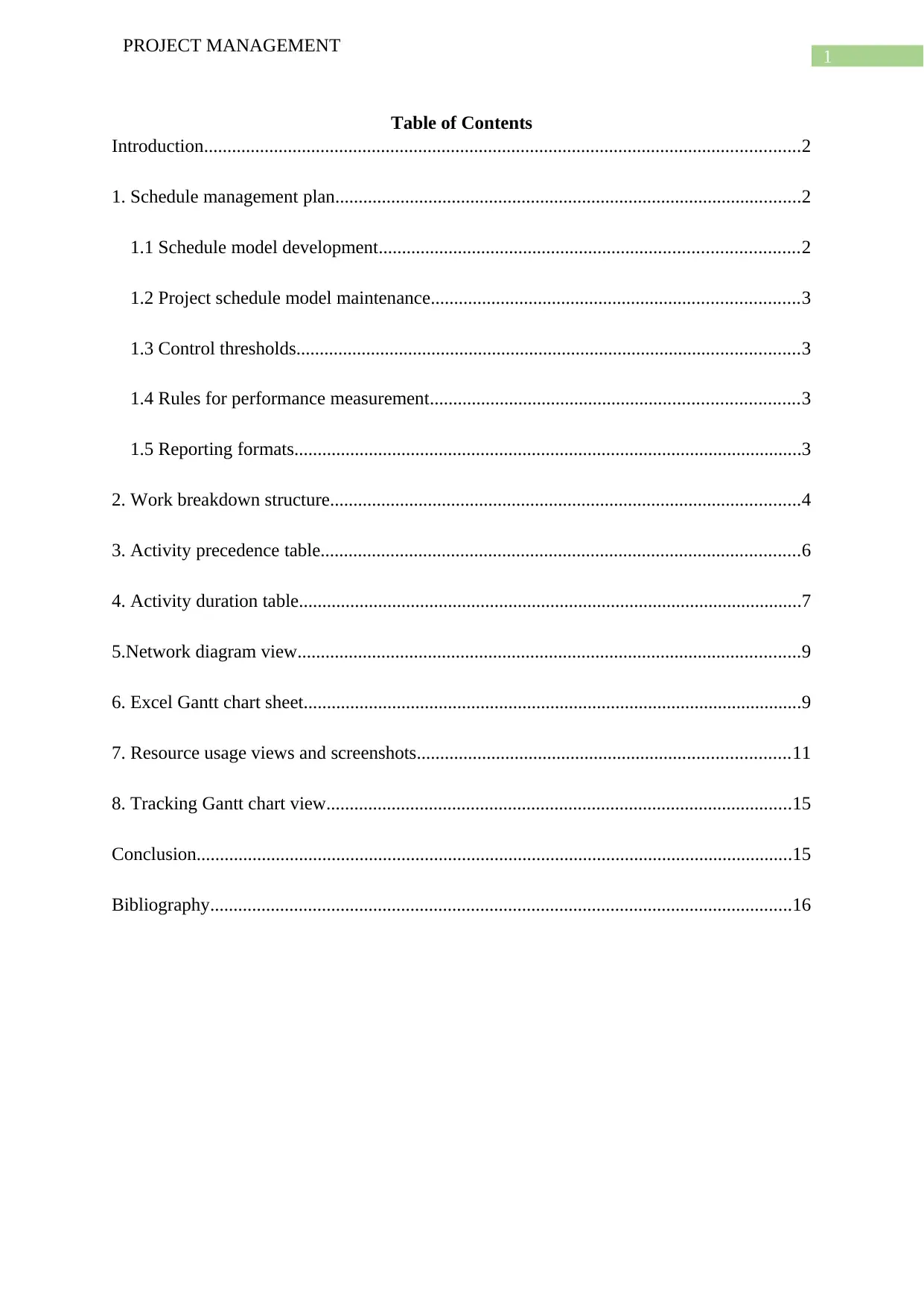
1
PROJECT MANAGEMENT
Table of Contents
Introduction................................................................................................................................2
1. Schedule management plan....................................................................................................2
1.1 Schedule model development..........................................................................................2
1.2 Project schedule model maintenance...............................................................................3
1.3 Control thresholds............................................................................................................3
1.4 Rules for performance measurement...............................................................................3
1.5 Reporting formats.............................................................................................................3
2. Work breakdown structure.....................................................................................................4
3. Activity precedence table.......................................................................................................6
4. Activity duration table............................................................................................................7
5.Network diagram view............................................................................................................9
6. Excel Gantt chart sheet...........................................................................................................9
7. Resource usage views and screenshots................................................................................11
8. Tracking Gantt chart view....................................................................................................15
Conclusion................................................................................................................................15
Bibliography.............................................................................................................................16
PROJECT MANAGEMENT
Table of Contents
Introduction................................................................................................................................2
1. Schedule management plan....................................................................................................2
1.1 Schedule model development..........................................................................................2
1.2 Project schedule model maintenance...............................................................................3
1.3 Control thresholds............................................................................................................3
1.4 Rules for performance measurement...............................................................................3
1.5 Reporting formats.............................................................................................................3
2. Work breakdown structure.....................................................................................................4
3. Activity precedence table.......................................................................................................6
4. Activity duration table............................................................................................................7
5.Network diagram view............................................................................................................9
6. Excel Gantt chart sheet...........................................................................................................9
7. Resource usage views and screenshots................................................................................11
8. Tracking Gantt chart view....................................................................................................15
Conclusion................................................................................................................................15
Bibliography.............................................................................................................................16
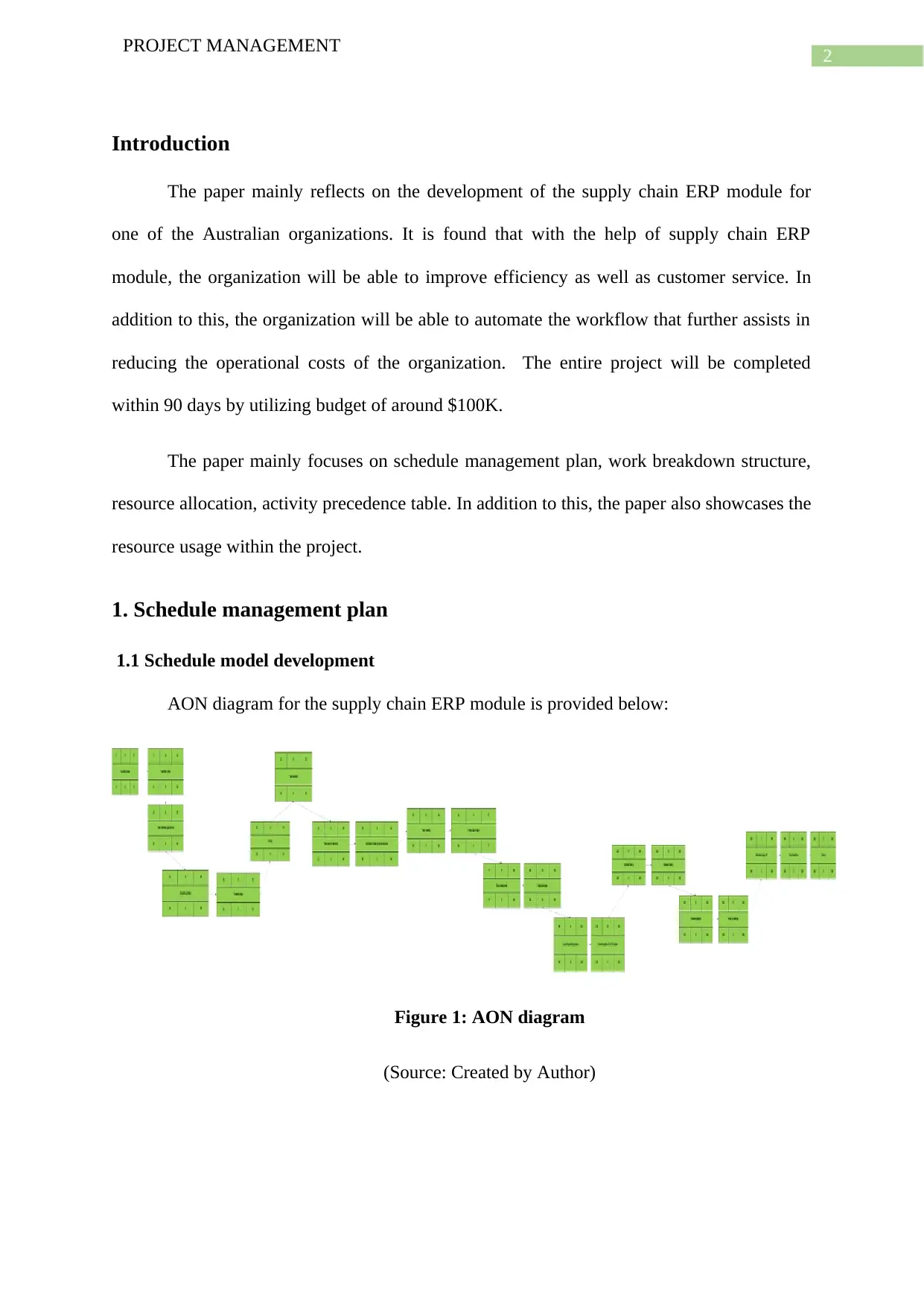
2
PROJECT MANAGEMENT
Introduction
The paper mainly reflects on the development of the supply chain ERP module for
one of the Australian organizations. It is found that with the help of supply chain ERP
module, the organization will be able to improve efficiency as well as customer service. In
addition to this, the organization will be able to automate the workflow that further assists in
reducing the operational costs of the organization. The entire project will be completed
within 90 days by utilizing budget of around $100K.
The paper mainly focuses on schedule management plan, work breakdown structure,
resource allocation, activity precedence table. In addition to this, the paper also showcases the
resource usage within the project.
1. Schedule management plan
1.1 Schedule model development
AON diagram for the supply chain ERP module is provided below:
Figure 1: AON diagram
(Source: Created by Author)
PROJECT MANAGEMENT
Introduction
The paper mainly reflects on the development of the supply chain ERP module for
one of the Australian organizations. It is found that with the help of supply chain ERP
module, the organization will be able to improve efficiency as well as customer service. In
addition to this, the organization will be able to automate the workflow that further assists in
reducing the operational costs of the organization. The entire project will be completed
within 90 days by utilizing budget of around $100K.
The paper mainly focuses on schedule management plan, work breakdown structure,
resource allocation, activity precedence table. In addition to this, the paper also showcases the
resource usage within the project.
1. Schedule management plan
1.1 Schedule model development
AON diagram for the supply chain ERP module is provided below:
Figure 1: AON diagram
(Source: Created by Author)
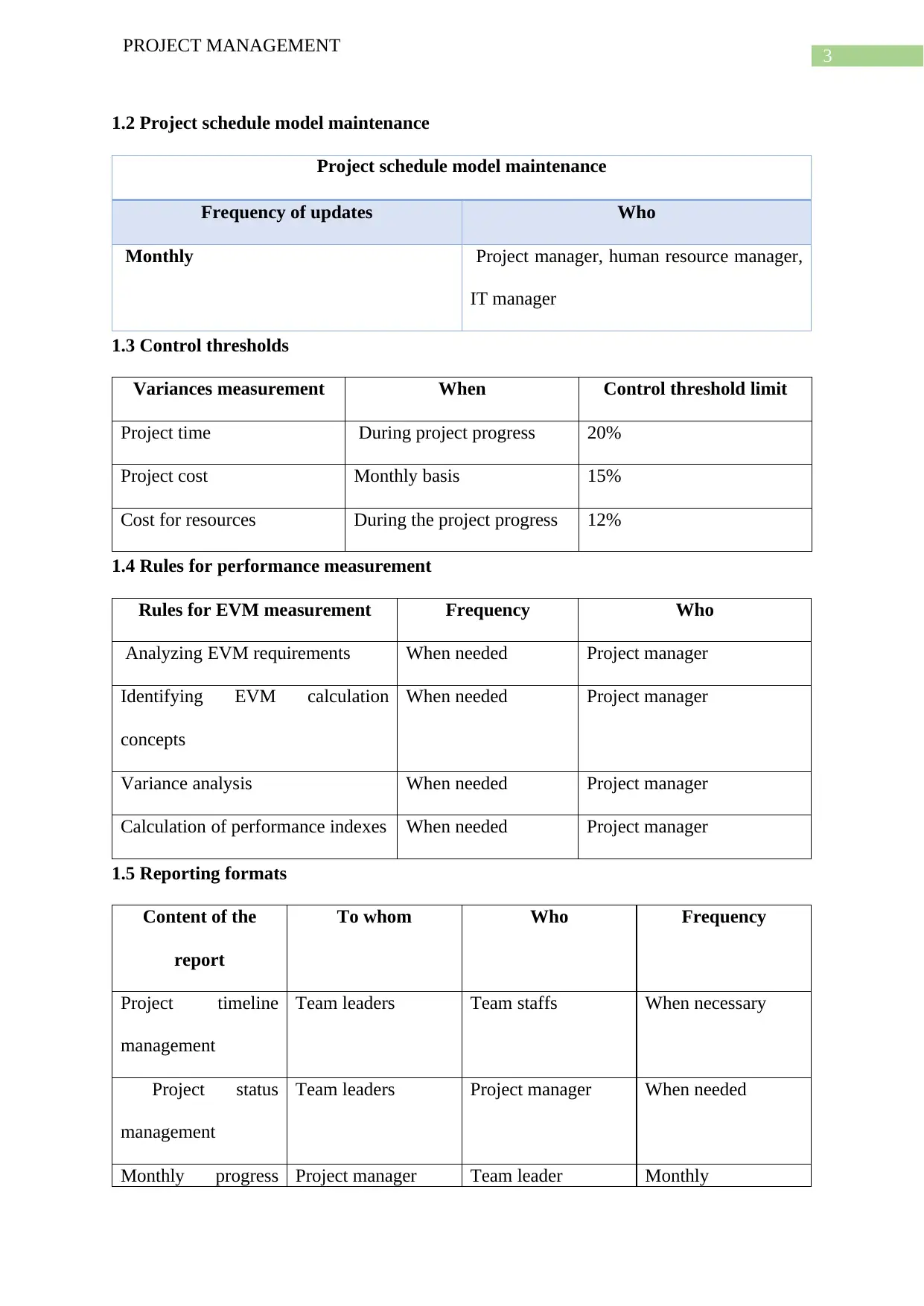
3
PROJECT MANAGEMENT
1.2 Project schedule model maintenance
Project schedule model maintenance
Frequency of updates Who
Monthly Project manager, human resource manager,
IT manager
1.3 Control thresholds
Variances measurement When Control threshold limit
Project time During project progress 20%
Project cost Monthly basis 15%
Cost for resources During the project progress 12%
1.4 Rules for performance measurement
Rules for EVM measurement Frequency Who
Analyzing EVM requirements When needed Project manager
Identifying EVM calculation
concepts
When needed Project manager
Variance analysis When needed Project manager
Calculation of performance indexes When needed Project manager
1.5 Reporting formats
Content of the
report
To whom Who Frequency
Project timeline
management
Team leaders Team staffs When necessary
Project status
management
Team leaders Project manager When needed
Monthly progress Project manager Team leader Monthly
PROJECT MANAGEMENT
1.2 Project schedule model maintenance
Project schedule model maintenance
Frequency of updates Who
Monthly Project manager, human resource manager,
IT manager
1.3 Control thresholds
Variances measurement When Control threshold limit
Project time During project progress 20%
Project cost Monthly basis 15%
Cost for resources During the project progress 12%
1.4 Rules for performance measurement
Rules for EVM measurement Frequency Who
Analyzing EVM requirements When needed Project manager
Identifying EVM calculation
concepts
When needed Project manager
Variance analysis When needed Project manager
Calculation of performance indexes When needed Project manager
1.5 Reporting formats
Content of the
report
To whom Who Frequency
Project timeline
management
Team leaders Team staffs When necessary
Project status
management
Team leaders Project manager When needed
Monthly progress Project manager Team leader Monthly
Secure Best Marks with AI Grader
Need help grading? Try our AI Grader for instant feedback on your assignments.
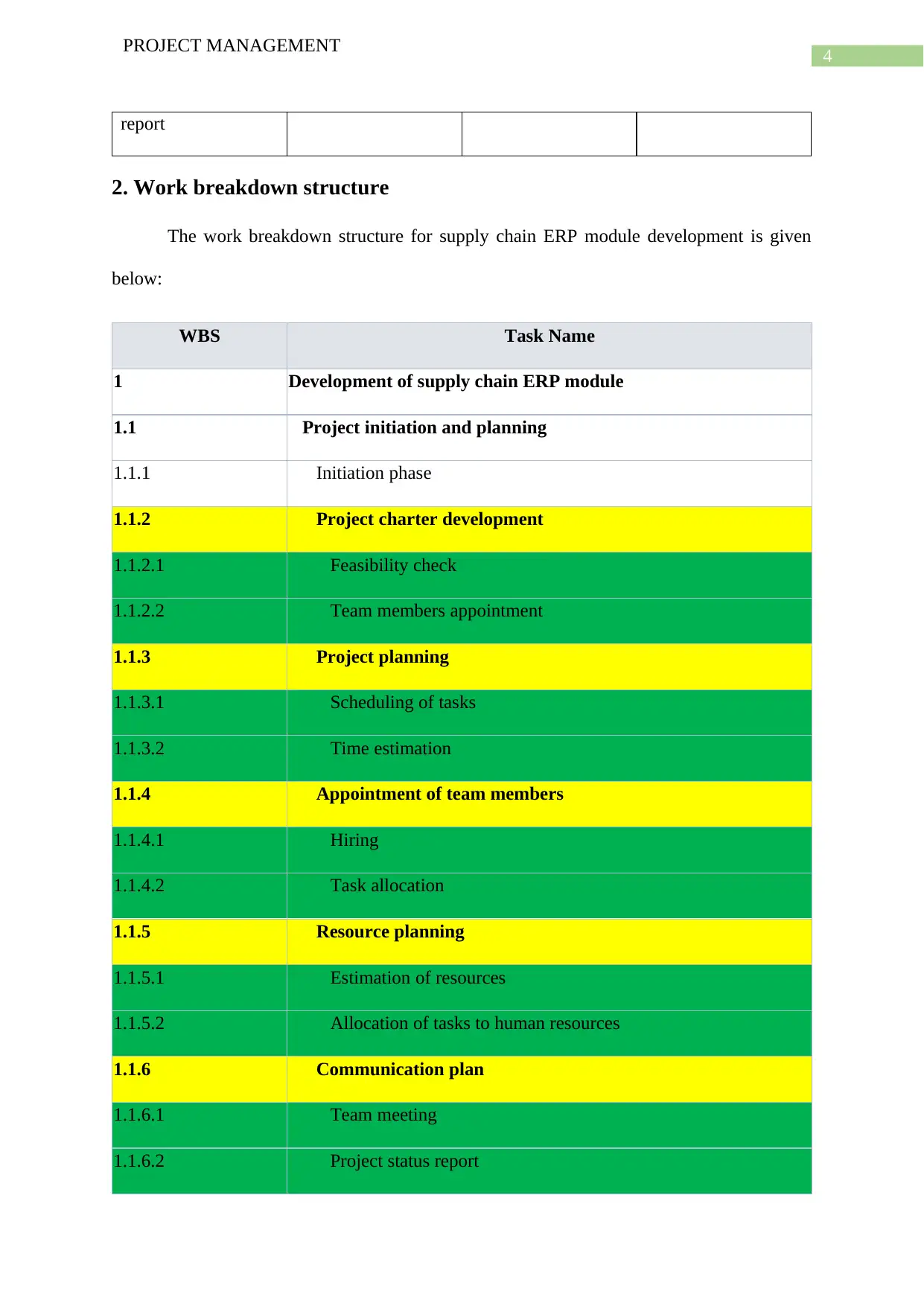
4
PROJECT MANAGEMENT
report
2. Work breakdown structure
The work breakdown structure for supply chain ERP module development is given
below:
WBS Task Name
1 Development of supply chain ERP module
1.1 Project initiation and planning
1.1.1 Initiation phase
1.1.2 Project charter development
1.1.2.1 Feasibility check
1.1.2.2 Team members appointment
1.1.3 Project planning
1.1.3.1 Scheduling of tasks
1.1.3.2 Time estimation
1.1.4 Appointment of team members
1.1.4.1 Hiring
1.1.4.2 Task allocation
1.1.5 Resource planning
1.1.5.1 Estimation of resources
1.1.5.2 Allocation of tasks to human resources
1.1.6 Communication plan
1.1.6.1 Team meeting
1.1.6.2 Project status report
PROJECT MANAGEMENT
report
2. Work breakdown structure
The work breakdown structure for supply chain ERP module development is given
below:
WBS Task Name
1 Development of supply chain ERP module
1.1 Project initiation and planning
1.1.1 Initiation phase
1.1.2 Project charter development
1.1.2.1 Feasibility check
1.1.2.2 Team members appointment
1.1.3 Project planning
1.1.3.1 Scheduling of tasks
1.1.3.2 Time estimation
1.1.4 Appointment of team members
1.1.4.1 Hiring
1.1.4.2 Task allocation
1.1.5 Resource planning
1.1.5.1 Estimation of resources
1.1.5.2 Allocation of tasks to human resources
1.1.6 Communication plan
1.1.6.1 Team meeting
1.1.6.2 Project status report
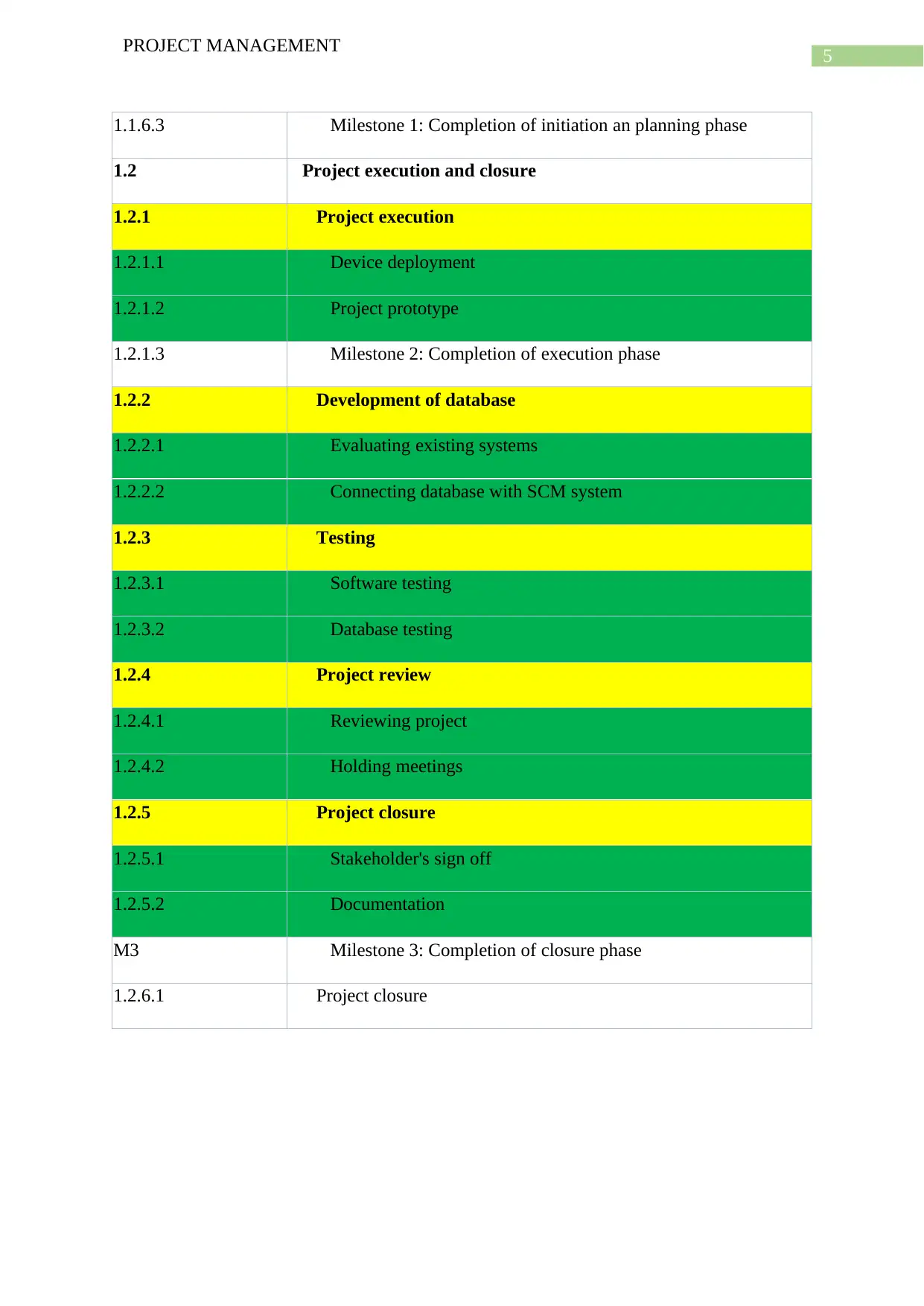
5
PROJECT MANAGEMENT
1.1.6.3 Milestone 1: Completion of initiation an planning phase
1.2 Project execution and closure
1.2.1 Project execution
1.2.1.1 Device deployment
1.2.1.2 Project prototype
1.2.1.3 Milestone 2: Completion of execution phase
1.2.2 Development of database
1.2.2.1 Evaluating existing systems
1.2.2.2 Connecting database with SCM system
1.2.3 Testing
1.2.3.1 Software testing
1.2.3.2 Database testing
1.2.4 Project review
1.2.4.1 Reviewing project
1.2.4.2 Holding meetings
1.2.5 Project closure
1.2.5.1 Stakeholder's sign off
1.2.5.2 Documentation
M3 Milestone 3: Completion of closure phase
1.2.6.1 Project closure
PROJECT MANAGEMENT
1.1.6.3 Milestone 1: Completion of initiation an planning phase
1.2 Project execution and closure
1.2.1 Project execution
1.2.1.1 Device deployment
1.2.1.2 Project prototype
1.2.1.3 Milestone 2: Completion of execution phase
1.2.2 Development of database
1.2.2.1 Evaluating existing systems
1.2.2.2 Connecting database with SCM system
1.2.3 Testing
1.2.3.1 Software testing
1.2.3.2 Database testing
1.2.4 Project review
1.2.4.1 Reviewing project
1.2.4.2 Holding meetings
1.2.5 Project closure
1.2.5.1 Stakeholder's sign off
1.2.5.2 Documentation
M3 Milestone 3: Completion of closure phase
1.2.6.1 Project closure
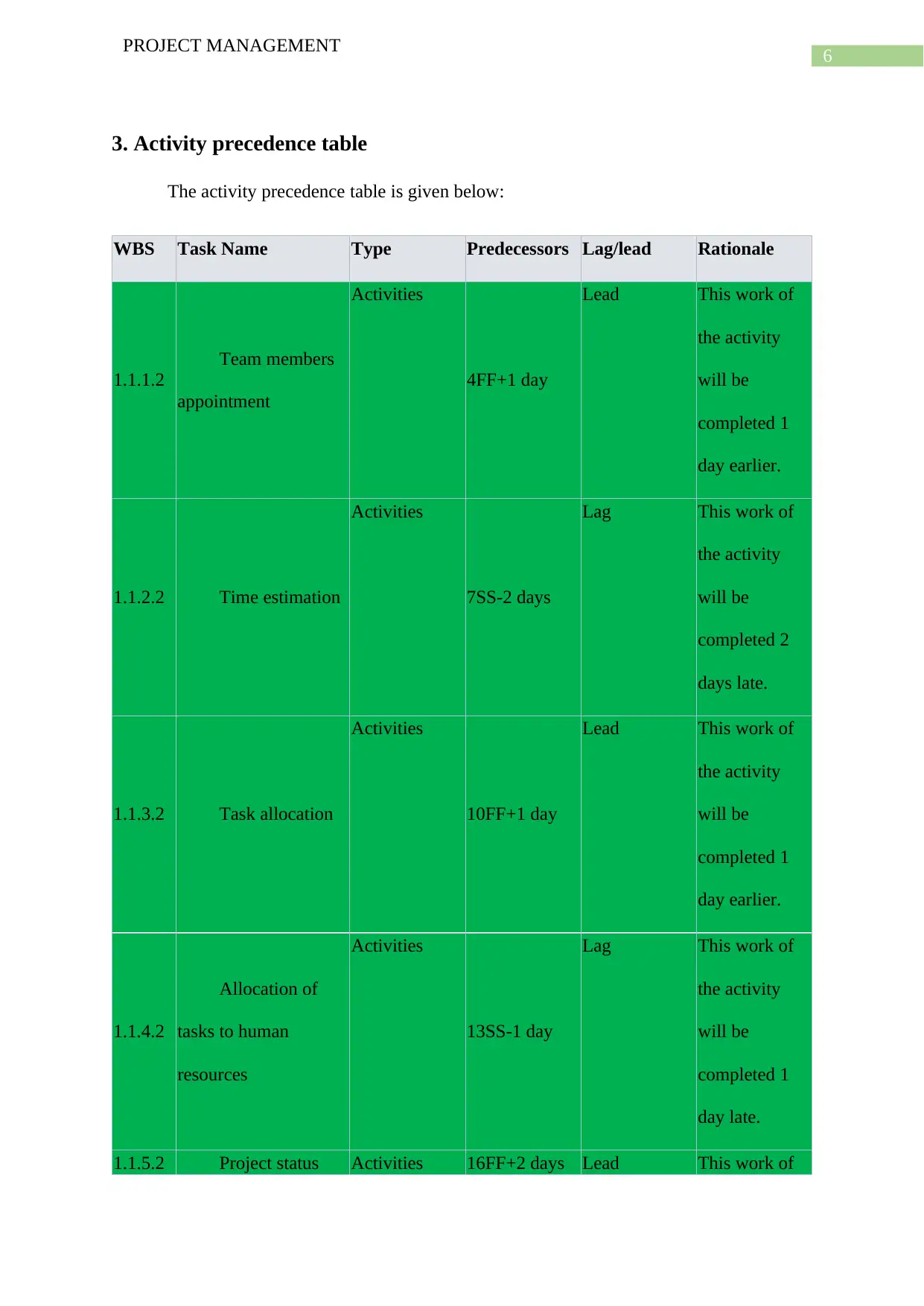
6
PROJECT MANAGEMENT
3. Activity precedence table
The activity precedence table is given below:
WBS Task Name Type Predecessors Lag/lead Rationale
1.1.1.2
Team members
appointment
Activities
4FF+1 day
Lead This work of
the activity
will be
completed 1
day earlier.
1.1.2.2 Time estimation
Activities
7SS-2 days
Lag This work of
the activity
will be
completed 2
days late.
1.1.3.2 Task allocation
Activities
10FF+1 day
Lead This work of
the activity
will be
completed 1
day earlier.
1.1.4.2
Allocation of
tasks to human
resources
Activities
13SS-1 day
Lag This work of
the activity
will be
completed 1
day late.
1.1.5.2 Project status Activities 16FF+2 days Lead This work of
PROJECT MANAGEMENT
3. Activity precedence table
The activity precedence table is given below:
WBS Task Name Type Predecessors Lag/lead Rationale
1.1.1.2
Team members
appointment
Activities
4FF+1 day
Lead This work of
the activity
will be
completed 1
day earlier.
1.1.2.2 Time estimation
Activities
7SS-2 days
Lag This work of
the activity
will be
completed 2
days late.
1.1.3.2 Task allocation
Activities
10FF+1 day
Lead This work of
the activity
will be
completed 1
day earlier.
1.1.4.2
Allocation of
tasks to human
resources
Activities
13SS-1 day
Lag This work of
the activity
will be
completed 1
day late.
1.1.5.2 Project status Activities 16FF+2 days Lead This work of
Paraphrase This Document
Need a fresh take? Get an instant paraphrase of this document with our AI Paraphraser
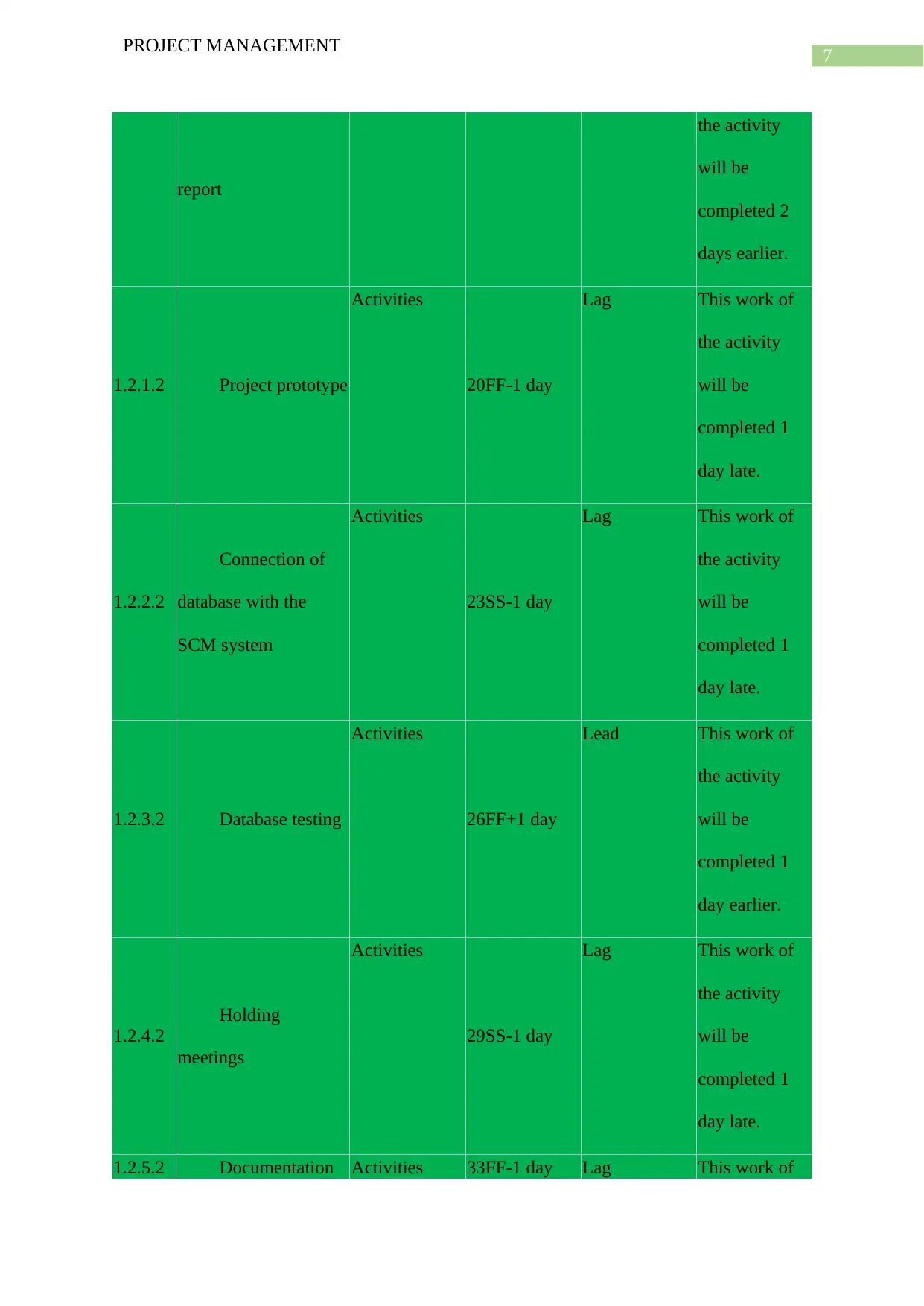
7
PROJECT MANAGEMENT
report
the activity
will be
completed 2
days earlier.
1.2.1.2 Project prototype
Activities
20FF-1 day
Lag This work of
the activity
will be
completed 1
day late.
1.2.2.2
Connection of
database with the
SCM system
Activities
23SS-1 day
Lag This work of
the activity
will be
completed 1
day late.
1.2.3.2 Database testing
Activities
26FF+1 day
Lead This work of
the activity
will be
completed 1
day earlier.
1.2.4.2
Holding
meetings
Activities
29SS-1 day
Lag This work of
the activity
will be
completed 1
day late.
1.2.5.2 Documentation Activities 33FF-1 day Lag This work of
PROJECT MANAGEMENT
report
the activity
will be
completed 2
days earlier.
1.2.1.2 Project prototype
Activities
20FF-1 day
Lag This work of
the activity
will be
completed 1
day late.
1.2.2.2
Connection of
database with the
SCM system
Activities
23SS-1 day
Lag This work of
the activity
will be
completed 1
day late.
1.2.3.2 Database testing
Activities
26FF+1 day
Lead This work of
the activity
will be
completed 1
day earlier.
1.2.4.2
Holding
meetings
Activities
29SS-1 day
Lag This work of
the activity
will be
completed 1
day late.
1.2.5.2 Documentation Activities 33FF-1 day Lag This work of
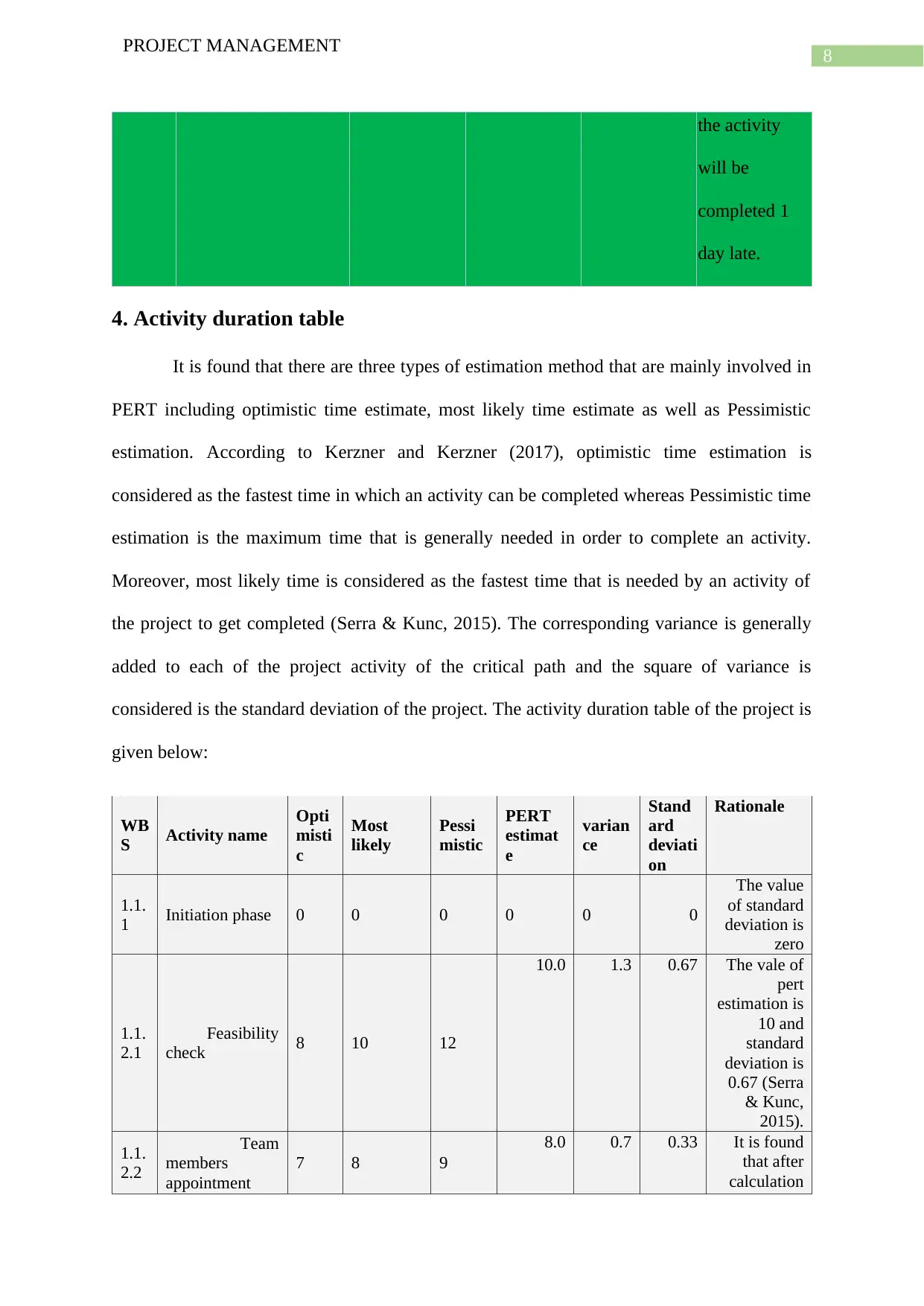
8
PROJECT MANAGEMENT
the activity
will be
completed 1
day late.
4. Activity duration table
It is found that there are three types of estimation method that are mainly involved in
PERT including optimistic time estimate, most likely time estimate as well as Pessimistic
estimation. According to Kerzner and Kerzner (2017), optimistic time estimation is
considered as the fastest time in which an activity can be completed whereas Pessimistic time
estimation is the maximum time that is generally needed in order to complete an activity.
Moreover, most likely time is considered as the fastest time that is needed by an activity of
the project to get completed (Serra & Kunc, 2015). The corresponding variance is generally
added to each of the project activity of the critical path and the square of variance is
considered is the standard deviation of the project. The activity duration table of the project is
given below:
WB
S Activity name
Opti
misti
c
Most
likely
Pessi
mistic
PERT
estimat
e
varian
ce
Stand
ard
deviati
on
Rationale
1.1.
1 Initiation phase 0 0 0 0 0 0
The value
of standard
deviation is
zero
1.1.
2.1
Feasibility
check 8 10 12
10.0 1.3 0.67 The vale of
pert
estimation is
10 and
standard
deviation is
0.67 (Serra
& Kunc,
2015).
1.1.
2.2
Team
members
appointment
7 8 9
8.0 0.7 0.33 It is found
that after
calculation
PROJECT MANAGEMENT
the activity
will be
completed 1
day late.
4. Activity duration table
It is found that there are three types of estimation method that are mainly involved in
PERT including optimistic time estimate, most likely time estimate as well as Pessimistic
estimation. According to Kerzner and Kerzner (2017), optimistic time estimation is
considered as the fastest time in which an activity can be completed whereas Pessimistic time
estimation is the maximum time that is generally needed in order to complete an activity.
Moreover, most likely time is considered as the fastest time that is needed by an activity of
the project to get completed (Serra & Kunc, 2015). The corresponding variance is generally
added to each of the project activity of the critical path and the square of variance is
considered is the standard deviation of the project. The activity duration table of the project is
given below:
WB
S Activity name
Opti
misti
c
Most
likely
Pessi
mistic
PERT
estimat
e
varian
ce
Stand
ard
deviati
on
Rationale
1.1.
1 Initiation phase 0 0 0 0 0 0
The value
of standard
deviation is
zero
1.1.
2.1
Feasibility
check 8 10 12
10.0 1.3 0.67 The vale of
pert
estimation is
10 and
standard
deviation is
0.67 (Serra
& Kunc,
2015).
1.1.
2.2
Team
members
appointment
7 8 9
8.0 0.7 0.33 It is found
that after
calculation
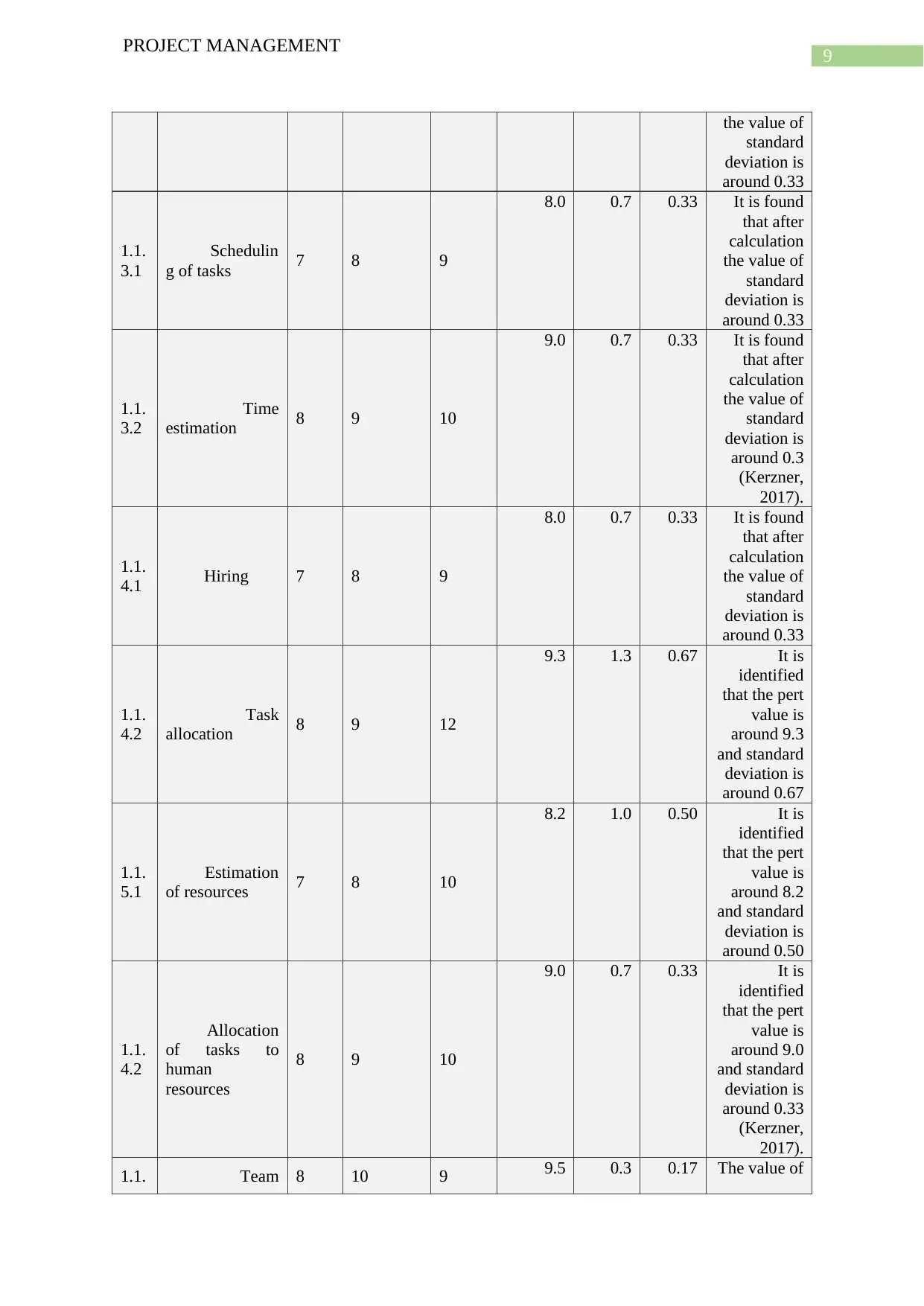
9
PROJECT MANAGEMENT
the value of
standard
deviation is
around 0.33
1.1.
3.1
Schedulin
g of tasks 7 8 9
8.0 0.7 0.33 It is found
that after
calculation
the value of
standard
deviation is
around 0.33
1.1.
3.2
Time
estimation 8 9 10
9.0 0.7 0.33 It is found
that after
calculation
the value of
standard
deviation is
around 0.3
(Kerzner,
2017).
1.1.
4.1 Hiring 7 8 9
8.0 0.7 0.33 It is found
that after
calculation
the value of
standard
deviation is
around 0.33
1.1.
4.2
Task
allocation 8 9 12
9.3 1.3 0.67 It is
identified
that the pert
value is
around 9.3
and standard
deviation is
around 0.67
1.1.
5.1
Estimation
of resources 7 8 10
8.2 1.0 0.50 It is
identified
that the pert
value is
around 8.2
and standard
deviation is
around 0.50
1.1.
4.2
Allocation
of tasks to
human
resources
8 9 10
9.0 0.7 0.33 It is
identified
that the pert
value is
around 9.0
and standard
deviation is
around 0.33
(Kerzner,
2017).
1.1. Team 8 10 9 9.5 0.3 0.17 The value of
PROJECT MANAGEMENT
the value of
standard
deviation is
around 0.33
1.1.
3.1
Schedulin
g of tasks 7 8 9
8.0 0.7 0.33 It is found
that after
calculation
the value of
standard
deviation is
around 0.33
1.1.
3.2
Time
estimation 8 9 10
9.0 0.7 0.33 It is found
that after
calculation
the value of
standard
deviation is
around 0.3
(Kerzner,
2017).
1.1.
4.1 Hiring 7 8 9
8.0 0.7 0.33 It is found
that after
calculation
the value of
standard
deviation is
around 0.33
1.1.
4.2
Task
allocation 8 9 12
9.3 1.3 0.67 It is
identified
that the pert
value is
around 9.3
and standard
deviation is
around 0.67
1.1.
5.1
Estimation
of resources 7 8 10
8.2 1.0 0.50 It is
identified
that the pert
value is
around 8.2
and standard
deviation is
around 0.50
1.1.
4.2
Allocation
of tasks to
human
resources
8 9 10
9.0 0.7 0.33 It is
identified
that the pert
value is
around 9.0
and standard
deviation is
around 0.33
(Kerzner,
2017).
1.1. Team 8 10 9 9.5 0.3 0.17 The value of
Secure Best Marks with AI Grader
Need help grading? Try our AI Grader for instant feedback on your assignments.
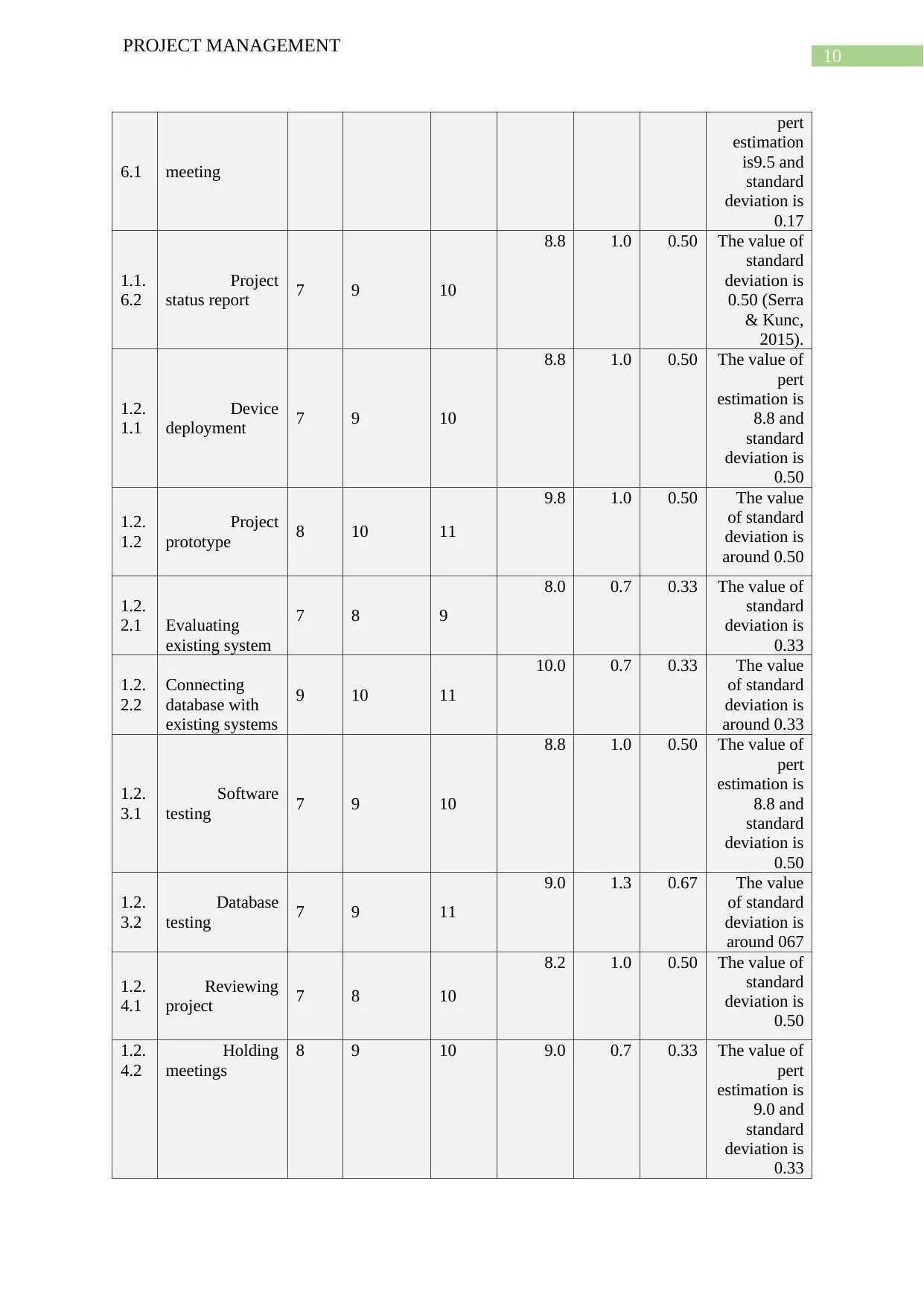
10
PROJECT MANAGEMENT
6.1 meeting
pert
estimation
is9.5 and
standard
deviation is
0.17
1.1.
6.2
Project
status report 7 9 10
8.8 1.0 0.50 The value of
standard
deviation is
0.50 (Serra
& Kunc,
2015).
1.2.
1.1
Device
deployment 7 9 10
8.8 1.0 0.50 The value of
pert
estimation is
8.8 and
standard
deviation is
0.50
1.2.
1.2
Project
prototype 8 10 11
9.8 1.0 0.50 The value
of standard
deviation is
around 0.50
1.2.
2.1 Evaluating
existing system
7 8 9
8.0 0.7 0.33 The value of
standard
deviation is
0.33
1.2.
2.2
Connecting
database with
existing systems
9 10 11
10.0 0.7 0.33 The value
of standard
deviation is
around 0.33
1.2.
3.1
Software
testing 7 9 10
8.8 1.0 0.50 The value of
pert
estimation is
8.8 and
standard
deviation is
0.50
1.2.
3.2
Database
testing 7 9 11
9.0 1.3 0.67 The value
of standard
deviation is
around 067
1.2.
4.1
Reviewing
project 7 8 10
8.2 1.0 0.50 The value of
standard
deviation is
0.50
1.2.
4.2
Holding
meetings
8 9 10 9.0 0.7 0.33 The value of
pert
estimation is
9.0 and
standard
deviation is
0.33
PROJECT MANAGEMENT
6.1 meeting
pert
estimation
is9.5 and
standard
deviation is
0.17
1.1.
6.2
Project
status report 7 9 10
8.8 1.0 0.50 The value of
standard
deviation is
0.50 (Serra
& Kunc,
2015).
1.2.
1.1
Device
deployment 7 9 10
8.8 1.0 0.50 The value of
pert
estimation is
8.8 and
standard
deviation is
0.50
1.2.
1.2
Project
prototype 8 10 11
9.8 1.0 0.50 The value
of standard
deviation is
around 0.50
1.2.
2.1 Evaluating
existing system
7 8 9
8.0 0.7 0.33 The value of
standard
deviation is
0.33
1.2.
2.2
Connecting
database with
existing systems
9 10 11
10.0 0.7 0.33 The value
of standard
deviation is
around 0.33
1.2.
3.1
Software
testing 7 9 10
8.8 1.0 0.50 The value of
pert
estimation is
8.8 and
standard
deviation is
0.50
1.2.
3.2
Database
testing 7 9 11
9.0 1.3 0.67 The value
of standard
deviation is
around 067
1.2.
4.1
Reviewing
project 7 8 10
8.2 1.0 0.50 The value of
standard
deviation is
0.50
1.2.
4.2
Holding
meetings
8 9 10 9.0 0.7 0.33 The value of
pert
estimation is
9.0 and
standard
deviation is
0.33
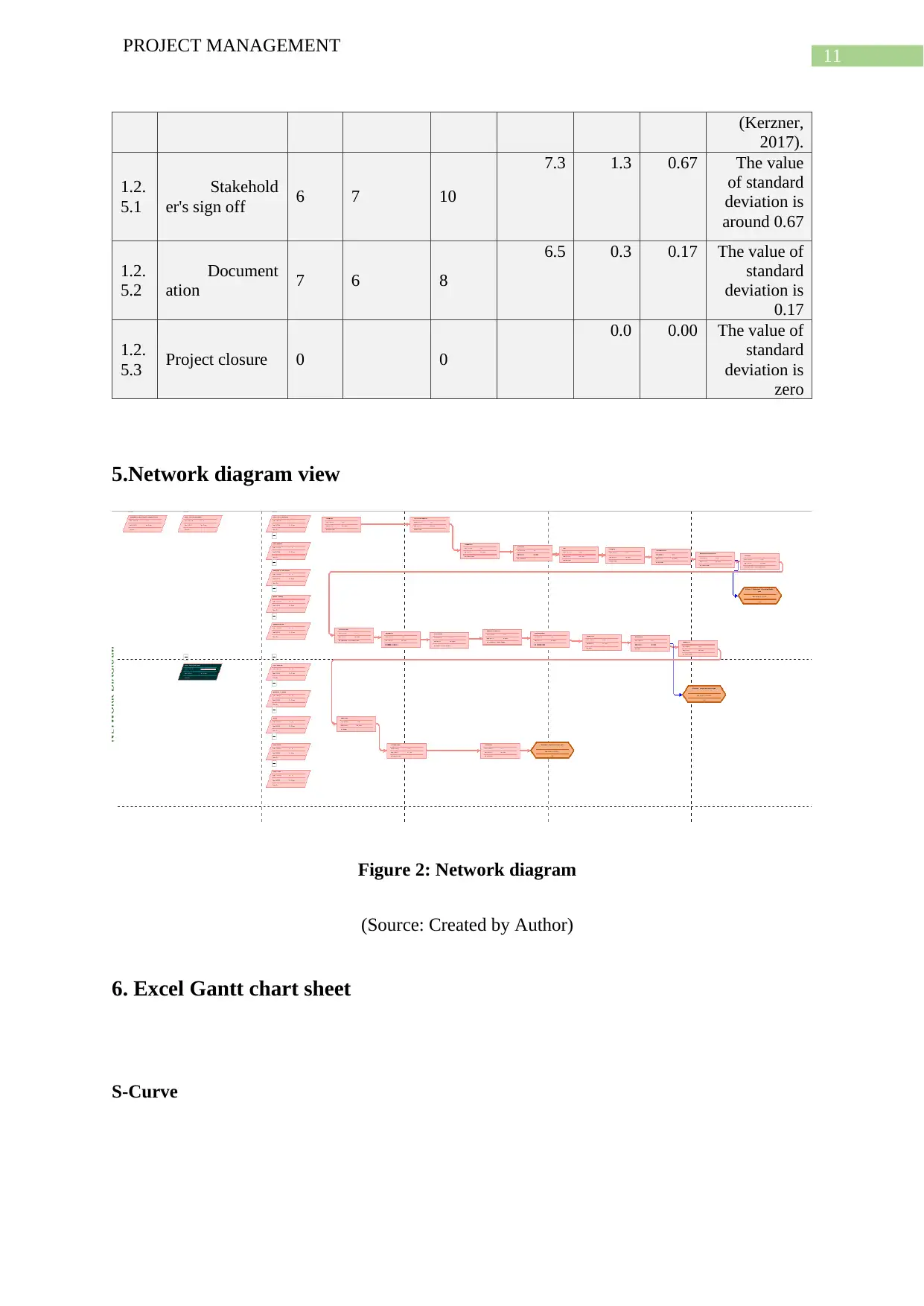
11
PROJECT MANAGEMENT
(Kerzner,
2017).
1.2.
5.1
Stakehold
er's sign off 6 7 10
7.3 1.3 0.67 The value
of standard
deviation is
around 0.67
1.2.
5.2
Document
ation 7 6 8
6.5 0.3 0.17 The value of
standard
deviation is
0.17
1.2.
5.3 Project closure 0 0
0.0 0.00 The value of
standard
deviation is
zero
5.Network diagram view
Figure 2: Network diagram
(Source: Created by Author)
6. Excel Gantt chart sheet
S-Curve
PROJECT MANAGEMENT
(Kerzner,
2017).
1.2.
5.1
Stakehold
er's sign off 6 7 10
7.3 1.3 0.67 The value
of standard
deviation is
around 0.67
1.2.
5.2
Document
ation 7 6 8
6.5 0.3 0.17 The value of
standard
deviation is
0.17
1.2.
5.3 Project closure 0 0
0.0 0.00 The value of
standard
deviation is
zero
5.Network diagram view
Figure 2: Network diagram
(Source: Created by Author)
6. Excel Gantt chart sheet
S-Curve
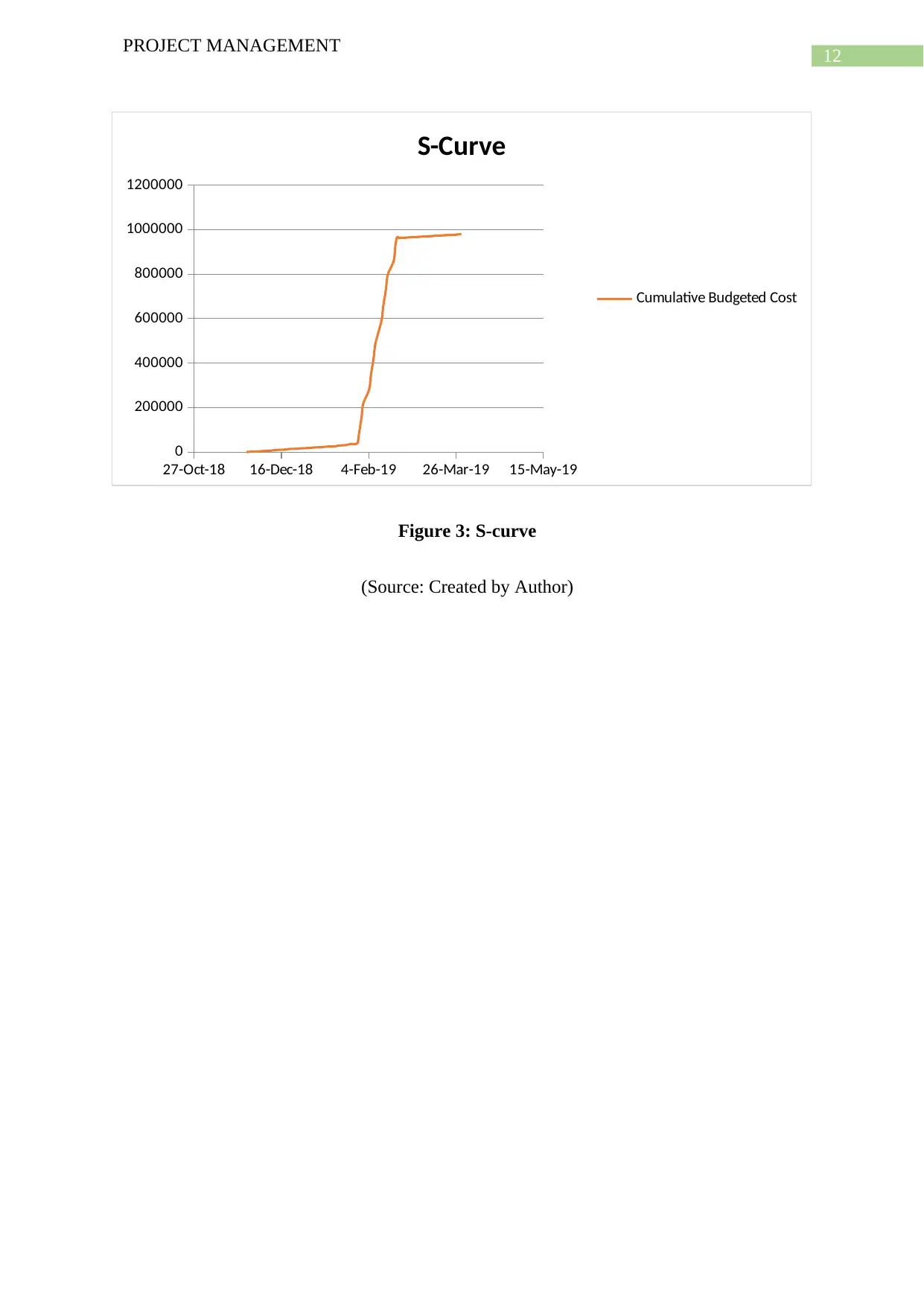
12
PROJECT MANAGEMENT
27-Oct-18 16-Dec-18 4-Feb-19 26-Mar-19 15-May-19
0
200000
400000
600000
800000
1000000
1200000
S-Curve
Cumulative Budgeted Cost
Figure 3: S-curve
(Source: Created by Author)
PROJECT MANAGEMENT
27-Oct-18 16-Dec-18 4-Feb-19 26-Mar-19 15-May-19
0
200000
400000
600000
800000
1000000
1200000
S-Curve
Cumulative Budgeted Cost
Figure 3: S-curve
(Source: Created by Author)
Paraphrase This Document
Need a fresh take? Get an instant paraphrase of this document with our AI Paraphraser
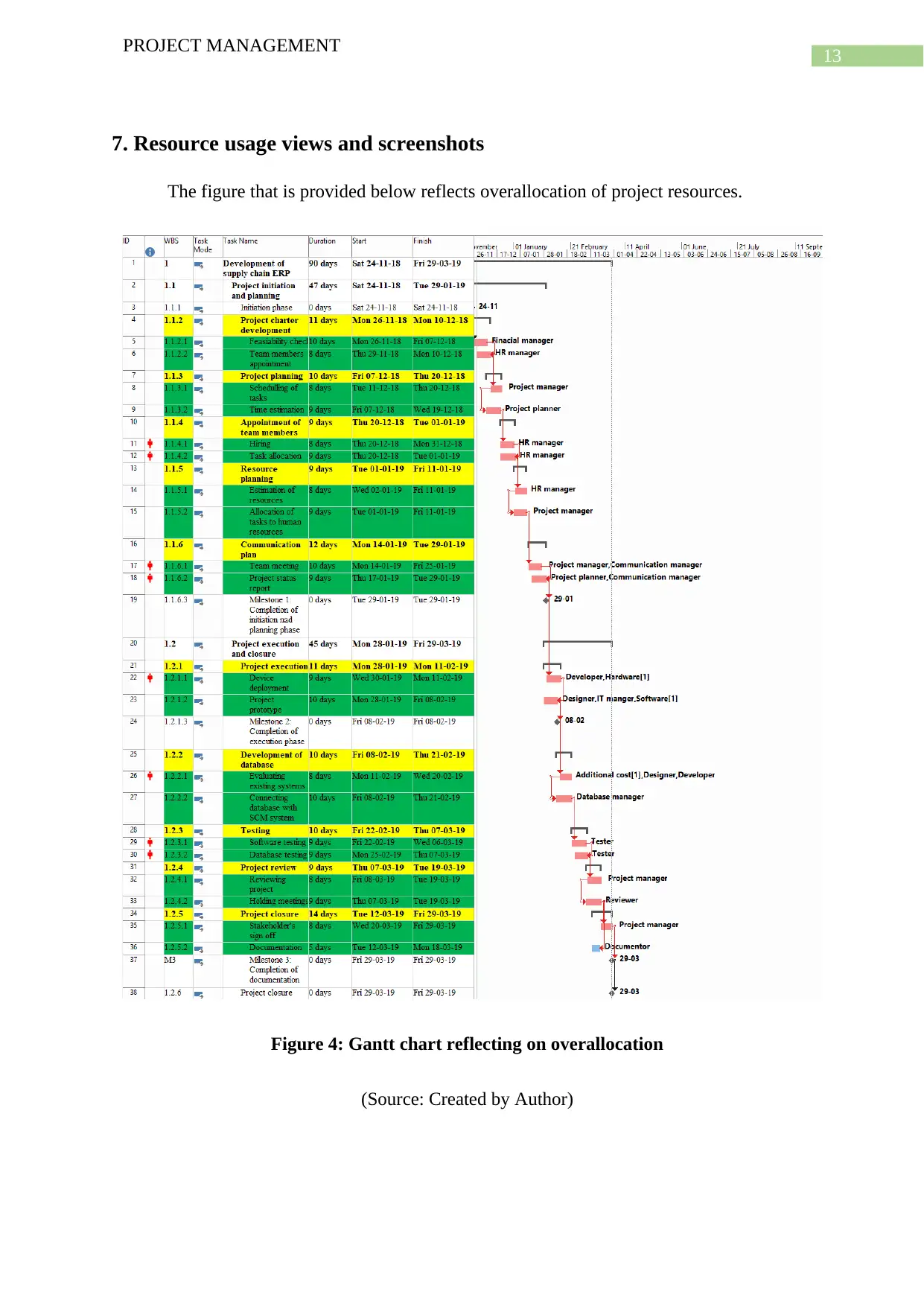
13
PROJECT MANAGEMENT
7. Resource usage views and screenshots
The figure that is provided below reflects overallocation of project resources.
Figure 4: Gantt chart reflecting on overallocation
(Source: Created by Author)
PROJECT MANAGEMENT
7. Resource usage views and screenshots
The figure that is provided below reflects overallocation of project resources.
Figure 4: Gantt chart reflecting on overallocation
(Source: Created by Author)
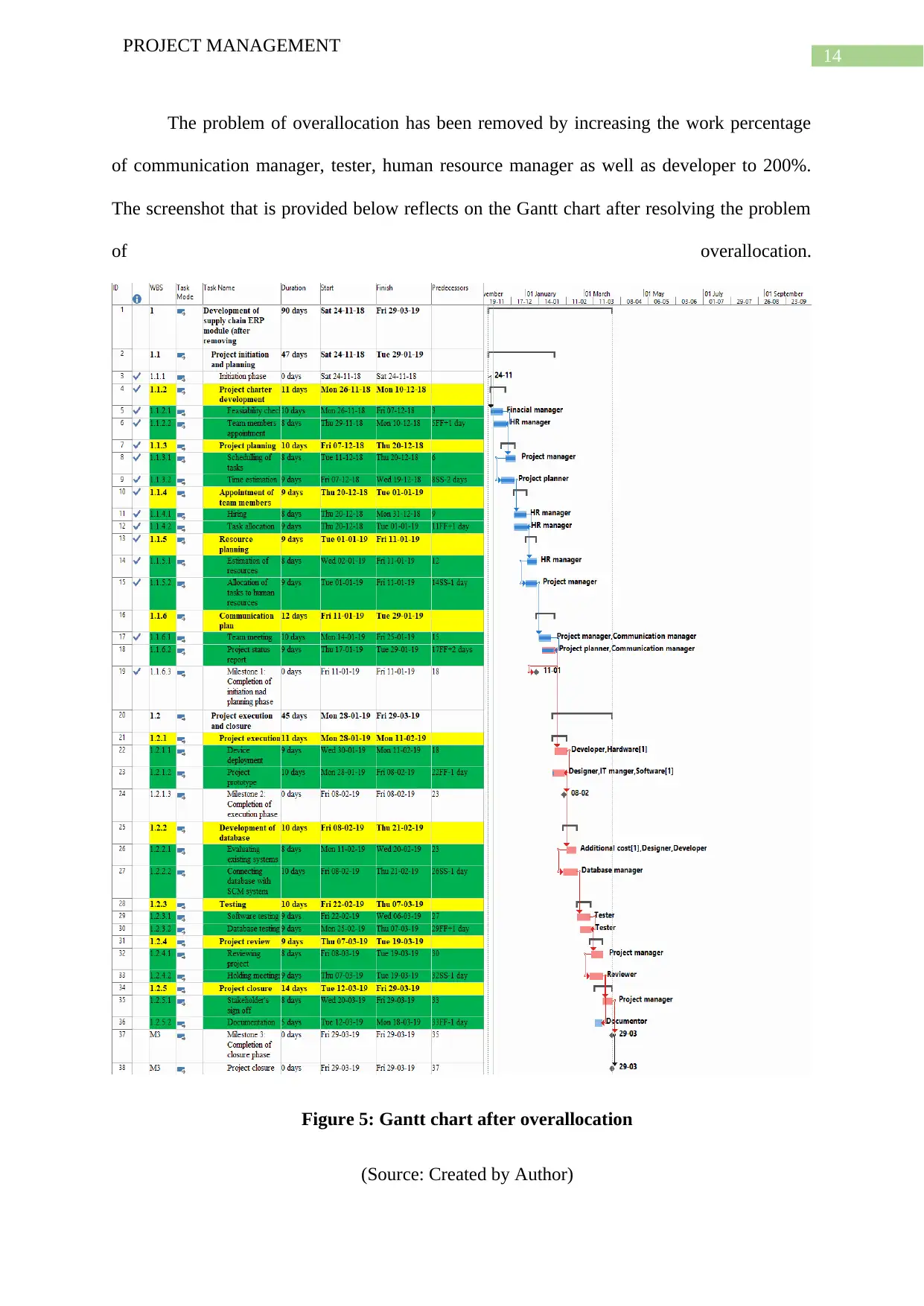
14
PROJECT MANAGEMENT
The problem of overallocation has been removed by increasing the work percentage
of communication manager, tester, human resource manager as well as developer to 200%.
The screenshot that is provided below reflects on the Gantt chart after resolving the problem
of overallocation.
Figure 5: Gantt chart after overallocation
(Source: Created by Author)
PROJECT MANAGEMENT
The problem of overallocation has been removed by increasing the work percentage
of communication manager, tester, human resource manager as well as developer to 200%.
The screenshot that is provided below reflects on the Gantt chart after resolving the problem
of overallocation.
Figure 5: Gantt chart after overallocation
(Source: Created by Author)
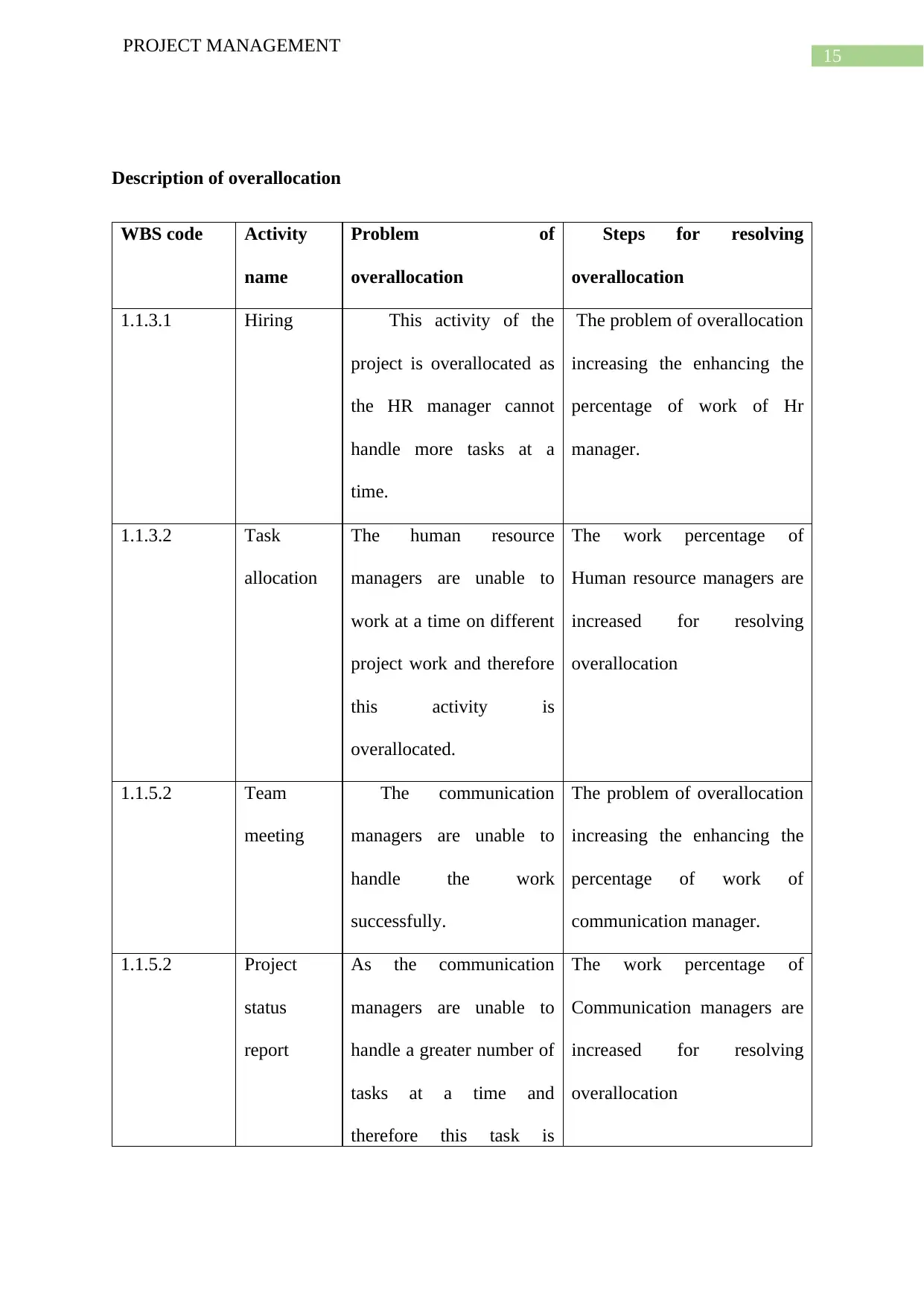
15
PROJECT MANAGEMENT
Description of overallocation
WBS code Activity
name
Problem of
overallocation
Steps for resolving
overallocation
1.1.3.1 Hiring This activity of the
project is overallocated as
the HR manager cannot
handle more tasks at a
time.
The problem of overallocation
increasing the enhancing the
percentage of work of Hr
manager.
1.1.3.2 Task
allocation
The human resource
managers are unable to
work at a time on different
project work and therefore
this activity is
overallocated.
The work percentage of
Human resource managers are
increased for resolving
overallocation
1.1.5.2 Team
meeting
The communication
managers are unable to
handle the work
successfully.
The problem of overallocation
increasing the enhancing the
percentage of work of
communication manager.
1.1.5.2 Project
status
report
As the communication
managers are unable to
handle a greater number of
tasks at a time and
therefore this task is
The work percentage of
Communication managers are
increased for resolving
overallocation
PROJECT MANAGEMENT
Description of overallocation
WBS code Activity
name
Problem of
overallocation
Steps for resolving
overallocation
1.1.3.1 Hiring This activity of the
project is overallocated as
the HR manager cannot
handle more tasks at a
time.
The problem of overallocation
increasing the enhancing the
percentage of work of Hr
manager.
1.1.3.2 Task
allocation
The human resource
managers are unable to
work at a time on different
project work and therefore
this activity is
overallocated.
The work percentage of
Human resource managers are
increased for resolving
overallocation
1.1.5.2 Team
meeting
The communication
managers are unable to
handle the work
successfully.
The problem of overallocation
increasing the enhancing the
percentage of work of
communication manager.
1.1.5.2 Project
status
report
As the communication
managers are unable to
handle a greater number of
tasks at a time and
therefore this task is
The work percentage of
Communication managers are
increased for resolving
overallocation
Secure Best Marks with AI Grader
Need help grading? Try our AI Grader for instant feedback on your assignments.
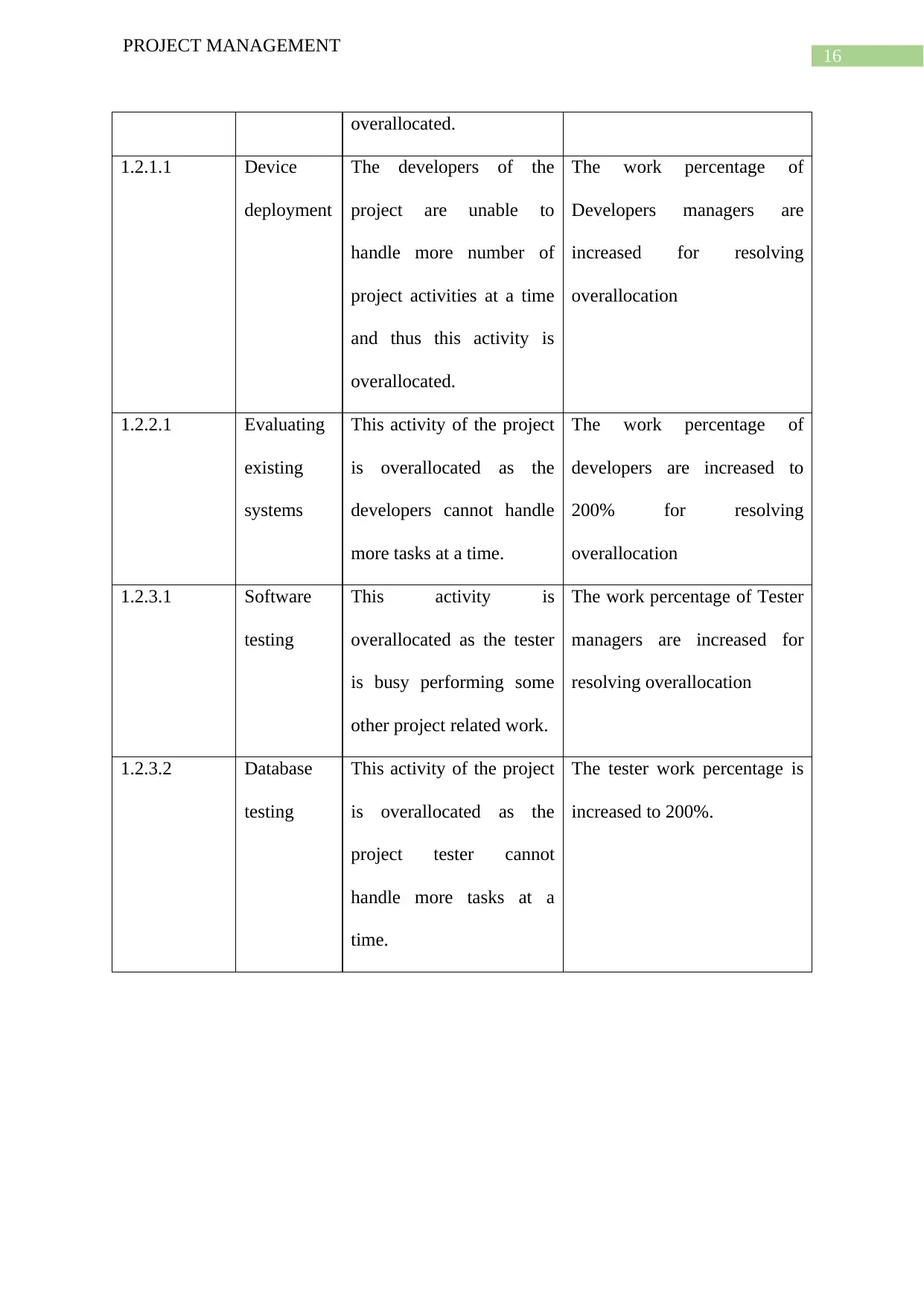
16
PROJECT MANAGEMENT
overallocated.
1.2.1.1 Device
deployment
The developers of the
project are unable to
handle more number of
project activities at a time
and thus this activity is
overallocated.
The work percentage of
Developers managers are
increased for resolving
overallocation
1.2.2.1 Evaluating
existing
systems
This activity of the project
is overallocated as the
developers cannot handle
more tasks at a time.
The work percentage of
developers are increased to
200% for resolving
overallocation
1.2.3.1 Software
testing
This activity is
overallocated as the tester
is busy performing some
other project related work.
The work percentage of Tester
managers are increased for
resolving overallocation
1.2.3.2 Database
testing
This activity of the project
is overallocated as the
project tester cannot
handle more tasks at a
time.
The tester work percentage is
increased to 200%.
PROJECT MANAGEMENT
overallocated.
1.2.1.1 Device
deployment
The developers of the
project are unable to
handle more number of
project activities at a time
and thus this activity is
overallocated.
The work percentage of
Developers managers are
increased for resolving
overallocation
1.2.2.1 Evaluating
existing
systems
This activity of the project
is overallocated as the
developers cannot handle
more tasks at a time.
The work percentage of
developers are increased to
200% for resolving
overallocation
1.2.3.1 Software
testing
This activity is
overallocated as the tester
is busy performing some
other project related work.
The work percentage of Tester
managers are increased for
resolving overallocation
1.2.3.2 Database
testing
This activity of the project
is overallocated as the
project tester cannot
handle more tasks at a
time.
The tester work percentage is
increased to 200%.
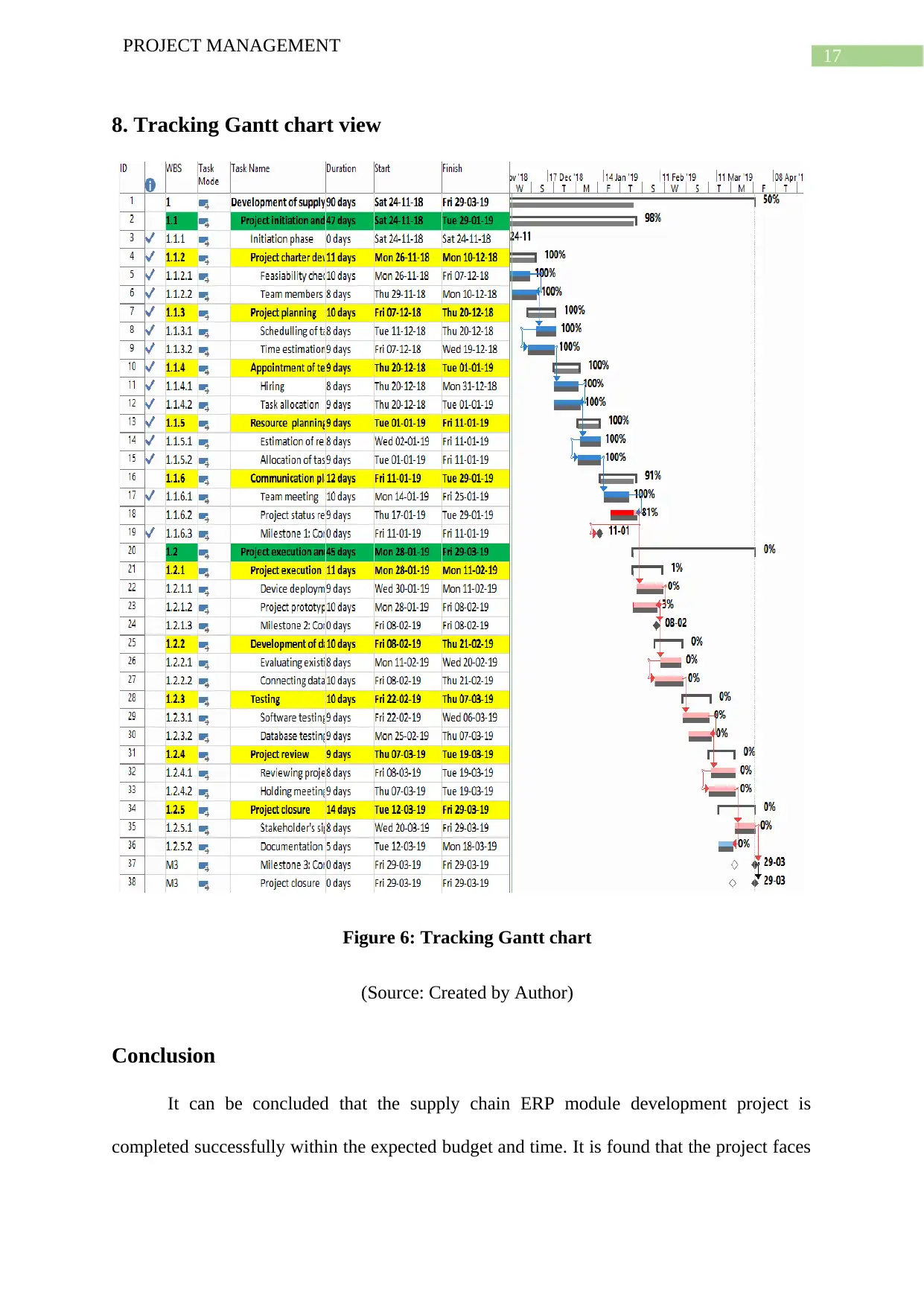
17
PROJECT MANAGEMENT
8. Tracking Gantt chart view
Figure 6: Tracking Gantt chart
(Source: Created by Author)
Conclusion
It can be concluded that the supply chain ERP module development project is
completed successfully within the expected budget and time. It is found that the project faces
PROJECT MANAGEMENT
8. Tracking Gantt chart view
Figure 6: Tracking Gantt chart
(Source: Created by Author)
Conclusion
It can be concluded that the supply chain ERP module development project is
completed successfully within the expected budget and time. It is found that the project faces
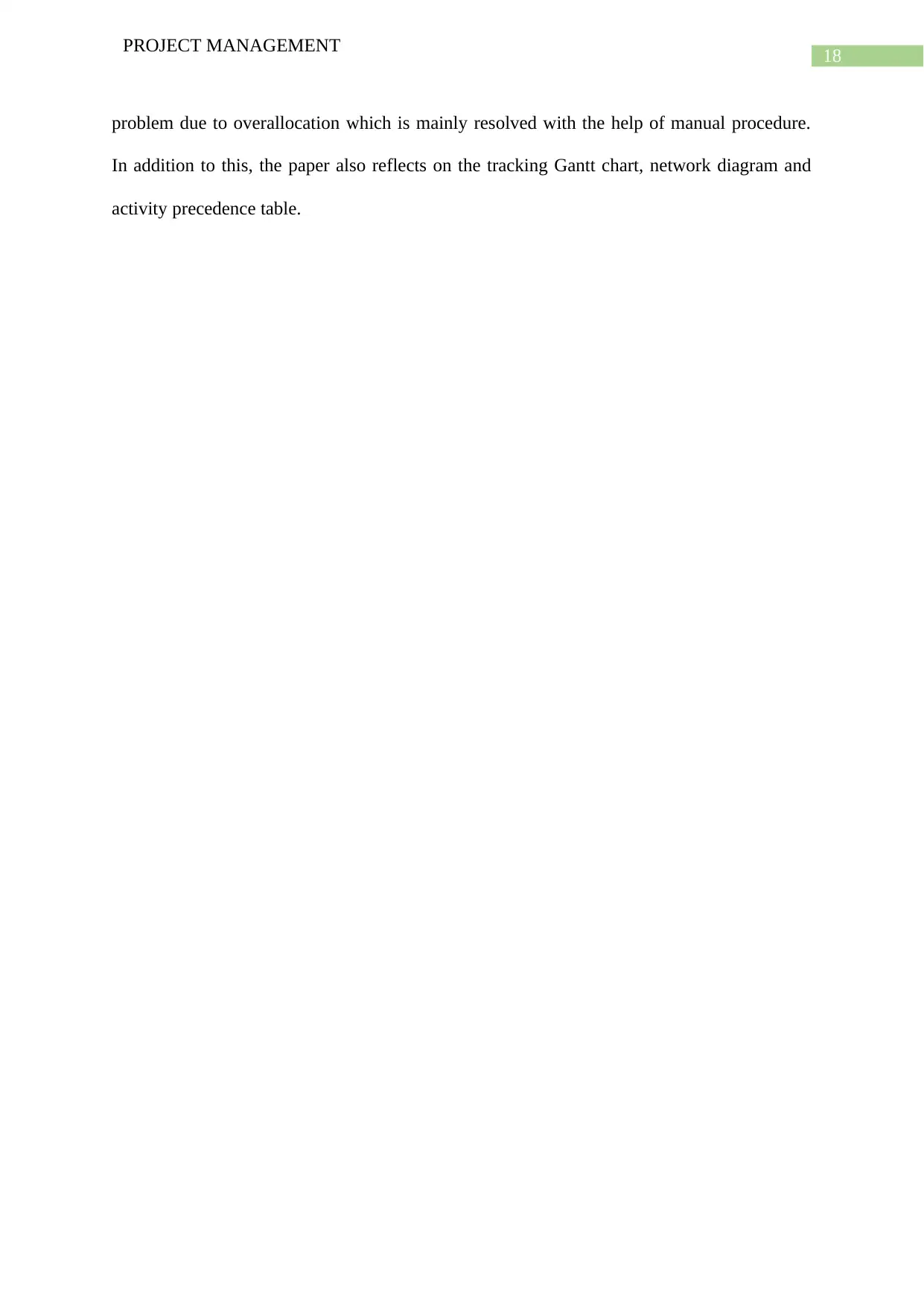
18
PROJECT MANAGEMENT
problem due to overallocation which is mainly resolved with the help of manual procedure.
In addition to this, the paper also reflects on the tracking Gantt chart, network diagram and
activity precedence table.
PROJECT MANAGEMENT
problem due to overallocation which is mainly resolved with the help of manual procedure.
In addition to this, the paper also reflects on the tracking Gantt chart, network diagram and
activity precedence table.
Paraphrase This Document
Need a fresh take? Get an instant paraphrase of this document with our AI Paraphraser
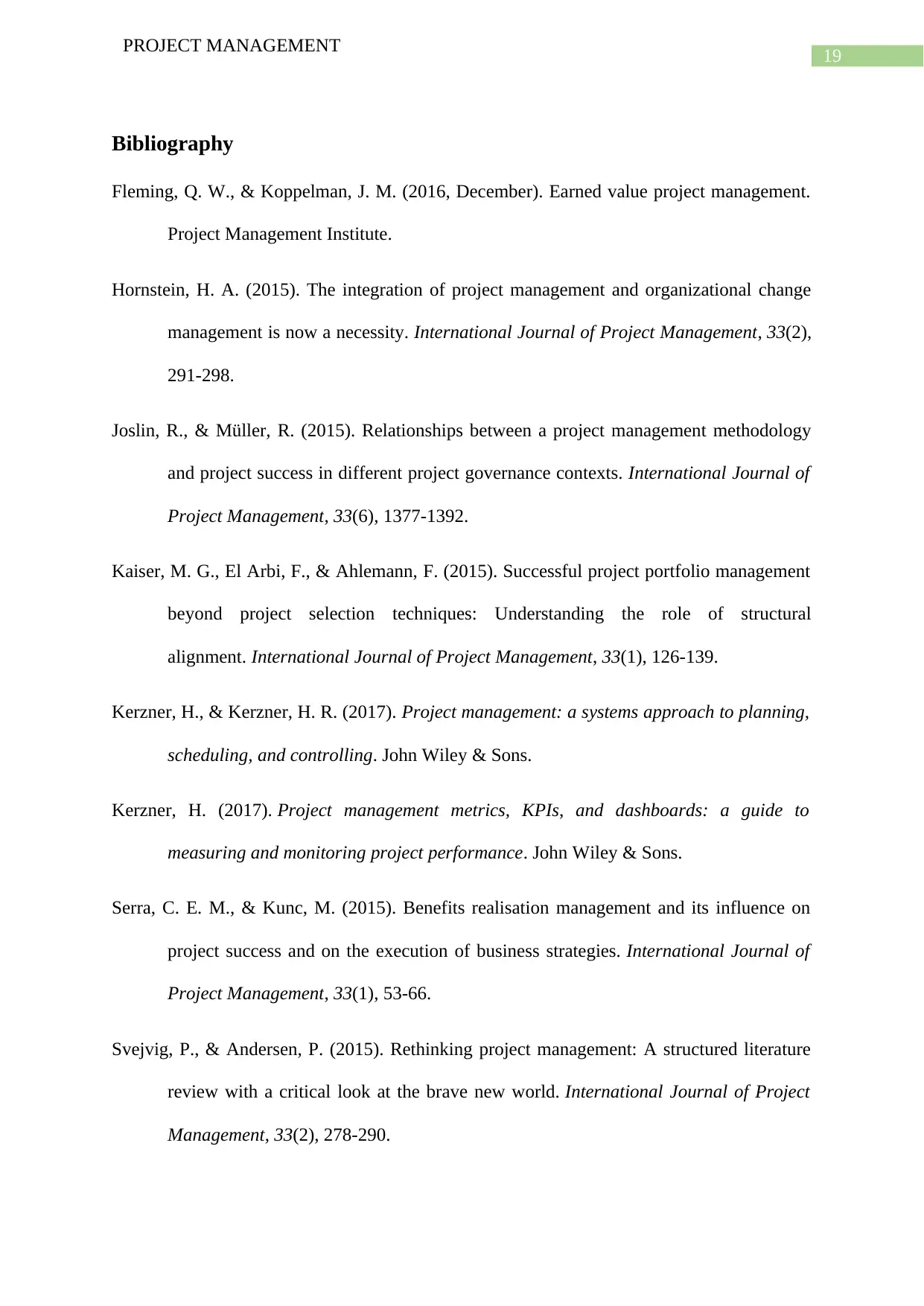
19
PROJECT MANAGEMENT
Bibliography
Fleming, Q. W., & Koppelman, J. M. (2016, December). Earned value project management.
Project Management Institute.
Hornstein, H. A. (2015). The integration of project management and organizational change
management is now a necessity. International Journal of Project Management, 33(2),
291-298.
Joslin, R., & Müller, R. (2015). Relationships between a project management methodology
and project success in different project governance contexts. International Journal of
Project Management, 33(6), 1377-1392.
Kaiser, M. G., El Arbi, F., & Ahlemann, F. (2015). Successful project portfolio management
beyond project selection techniques: Understanding the role of structural
alignment. International Journal of Project Management, 33(1), 126-139.
Kerzner, H., & Kerzner, H. R. (2017). Project management: a systems approach to planning,
scheduling, and controlling. John Wiley & Sons.
Kerzner, H. (2017). Project management metrics, KPIs, and dashboards: a guide to
measuring and monitoring project performance. John Wiley & Sons.
Serra, C. E. M., & Kunc, M. (2015). Benefits realisation management and its influence on
project success and on the execution of business strategies. International Journal of
Project Management, 33(1), 53-66.
Svejvig, P., & Andersen, P. (2015). Rethinking project management: A structured literature
review with a critical look at the brave new world. International Journal of Project
Management, 33(2), 278-290.
PROJECT MANAGEMENT
Bibliography
Fleming, Q. W., & Koppelman, J. M. (2016, December). Earned value project management.
Project Management Institute.
Hornstein, H. A. (2015). The integration of project management and organizational change
management is now a necessity. International Journal of Project Management, 33(2),
291-298.
Joslin, R., & Müller, R. (2015). Relationships between a project management methodology
and project success in different project governance contexts. International Journal of
Project Management, 33(6), 1377-1392.
Kaiser, M. G., El Arbi, F., & Ahlemann, F. (2015). Successful project portfolio management
beyond project selection techniques: Understanding the role of structural
alignment. International Journal of Project Management, 33(1), 126-139.
Kerzner, H., & Kerzner, H. R. (2017). Project management: a systems approach to planning,
scheduling, and controlling. John Wiley & Sons.
Kerzner, H. (2017). Project management metrics, KPIs, and dashboards: a guide to
measuring and monitoring project performance. John Wiley & Sons.
Serra, C. E. M., & Kunc, M. (2015). Benefits realisation management and its influence on
project success and on the execution of business strategies. International Journal of
Project Management, 33(1), 53-66.
Svejvig, P., & Andersen, P. (2015). Rethinking project management: A structured literature
review with a critical look at the brave new world. International Journal of Project
Management, 33(2), 278-290.
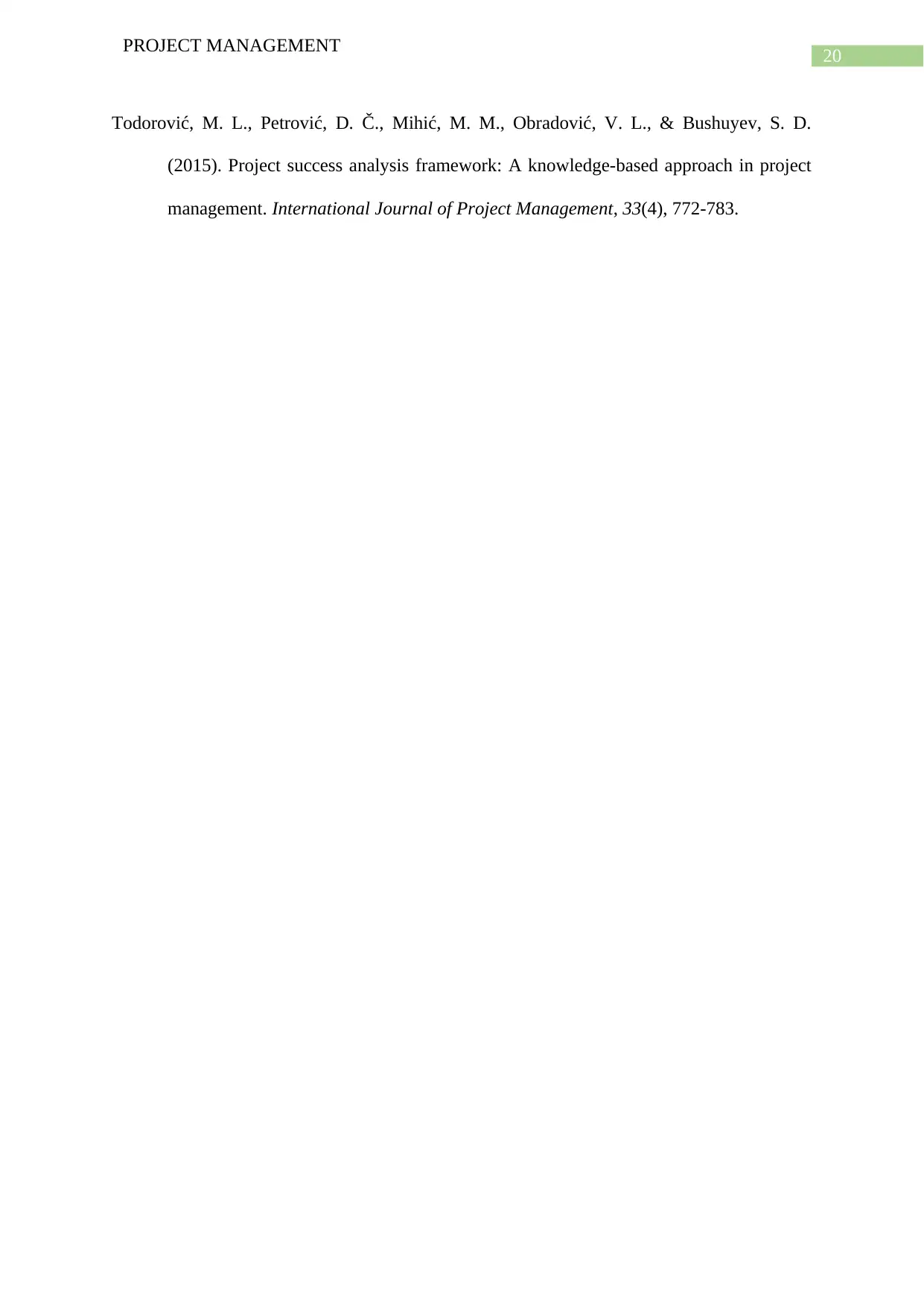
20
PROJECT MANAGEMENT
Todorović, M. L., Petrović, D. Č., Mihić, M. M., Obradović, V. L., & Bushuyev, S. D.
(2015). Project success analysis framework: A knowledge-based approach in project
management. International Journal of Project Management, 33(4), 772-783.
PROJECT MANAGEMENT
Todorović, M. L., Petrović, D. Č., Mihić, M. M., Obradović, V. L., & Bushuyev, S. D.
(2015). Project success analysis framework: A knowledge-based approach in project
management. International Journal of Project Management, 33(4), 772-783.
1 out of 21
Related Documents
Your All-in-One AI-Powered Toolkit for Academic Success.
+13062052269
info@desklib.com
Available 24*7 on WhatsApp / Email
![[object Object]](/_next/static/media/star-bottom.7253800d.svg)
Unlock your academic potential
© 2024 | Zucol Services PVT LTD | All rights reserved.




